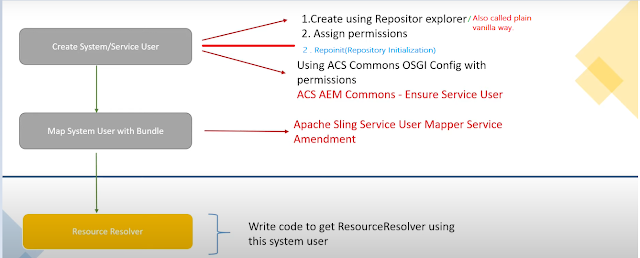System User/Service User
- System or service users in AEM are specific types of users designated to perform operations with minimal permissions within a particular bundle. Unlike regular users, they cannot log into AEM using typical credentials.
- It means they have specific kinds of users with which you can't log into AEM using normal login credentials, as you would for regular users. They have minimal permissions, meaning they are granted only the necessary permissions to perform their designated operations, and they are always mapped to a particular bundle.
- For example, if I have a resource that requires updating, specifically adding a particular property to it, I delegate this task to a service user that is associated with a specific bundle.
What is the need of System User/Service User?
- In AEM 6.0, when you needed to update content or resources programmatically, In AEM 6.0, there were two primary methods to obtain the necessary session or resolver from the repository:
- The administrative session
- The administrative Resource Resolver.
- Main Methods
- Session session = SlingRepository.loginAdministrative();
- ResourceResolver rr = resourceResolverFactory.getAdministrativeResourceResolver();
- Two operations to get resource Resolver or session using repository you will get administrative session or administrative resource Resolver by using this two methods we will get administrative permissions
- It means whole repository access that was breaking the principle of list privileges means
- If you have two main method session and Resource Resolver you could update whole repository.
- because you had all permissions it means all access.
- In order to address this issue, AEM introduced the concept of System User or Service User with version 6.1 .
How to create System user and How you can map those system user to a particular bundle?









No comments:
Post a Comment